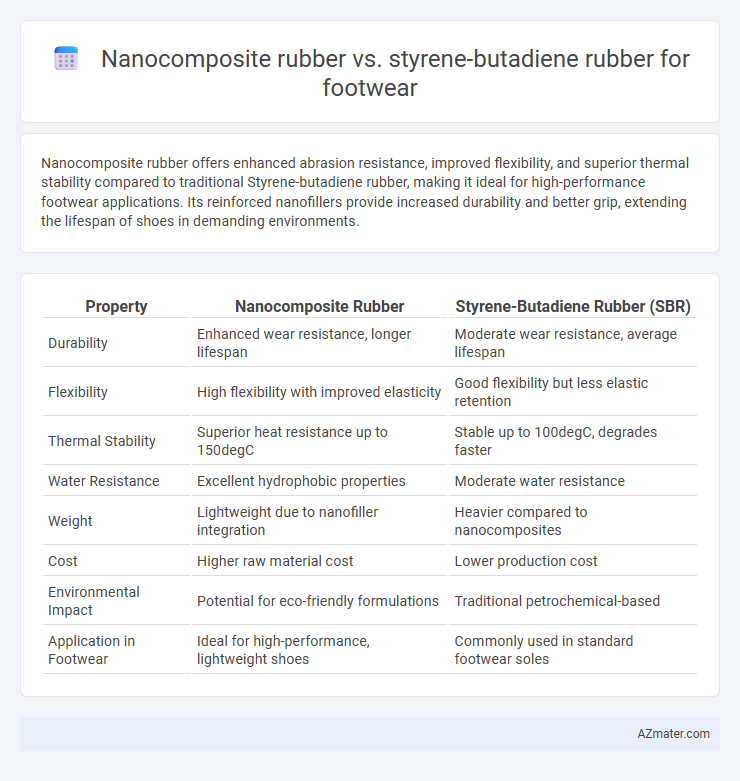Nanocomposite rubber offers enhanced abrasion resistance, improved flexibility, and superior thermal stability compared to traditional Styrene-butadiene rubber, making it ideal for high-performance footwear applications. Its reinforced nanofillers provide increased durability and better grip, extending the lifespan of shoes in demanding environments.
Table of Comparison
| Property | Nanocomposite Rubber | Styrene-Butadiene Rubber (SBR) |
|---|---|---|
| Durability | Enhanced wear resistance, longer lifespan | Moderate wear resistance, average lifespan |
| Flexibility | High flexibility with improved elasticity | Good flexibility but less elastic retention |
| Thermal Stability | Superior heat resistance up to 150degC | Stable up to 100degC, degrades faster |
| Water Resistance | Excellent hydrophobic properties | Moderate water resistance |
| Weight | Lightweight due to nanofiller integration | Heavier compared to nanocomposites |
| Cost | Higher raw material cost | Lower production cost |
| Environmental Impact | Potential for eco-friendly formulations | Traditional petrochemical-based |
| Application in Footwear | Ideal for high-performance, lightweight shoes | Commonly used in standard footwear soles |
Introduction to Footwear Rubber Materials
Nanocomposite rubber enhances traditional Styrene-butadiene rubber (SBR) by incorporating nanoscale fillers such as carbon nanotubes and silica, significantly improving durability, abrasion resistance, and elasticity in footwear applications. SBR remains a popular choice due to its excellent wear resistance, cost-effectiveness, and flexibility, making it ideal for midsoles and outsoles in athletic and casual shoes. Advances in nanocomposite technology provide superior mechanical properties and aging resistance, offering promising enhancements for high-performance footwear materials.
Overview of Nanocomposite Rubber
Nanocomposite rubber incorporates nanoscale fillers such as clay, silica, or carbon nanotubes to enhance mechanical strength, abrasion resistance, and flexibility compared to traditional Styrene-Butadiene Rubber (SBR). These nanofillers improve the rubber's thermal stability and durability, making nanocomposite rubber increasingly favored in high-performance footwear applications for enhanced lifespan and comfort. Unlike standard SBR, which relies on conventional fillers like carbon black, nanocomposite rubber offers superior dispersion and interfacial bonding, resulting in optimized traction and wear resistance essential for athletic and outdoor footwear.
Characteristics of Styrene-Butadiene Rubber (SBR)
Styrene-Butadiene Rubber (SBR) is a synthetic elastomer widely used in footwear due to its excellent abrasion resistance and aging stability. Its unique copolymer structure of styrene and butadiene provides good tensile strength and flexibility, making it suitable for midsoles and outsoles. Compared to nanocomposite rubber, SBR offers consistent performance in wet and dry conditions but generally lacks the enhanced mechanical properties and improved wear resistance found in nanocomposite variants.
Mechanical Properties Comparison
Nanocomposite rubber exhibits superior mechanical properties compared to styrene-butadiene rubber (SBR) in footwear applications, including enhanced tensile strength, abrasion resistance, and elasticity. The incorporation of nanoscale fillers such as carbon nanotubes or silica significantly improves load distribution and durability, resulting in extended product lifespan. SBR, while cost-effective and flexible, generally shows lower resistance to wear and mechanical stress, making nanocomposite rubber a preferred choice for high-performance and long-lasting footwear.
Durability and Wear Resistance
Nanocomposite rubber enhances footwear durability and wear resistance by integrating nanoparticles such as silica or carbon nanotubes, which improve the polymer matrix's strength and abrasion resistance compared to traditional Styrene-butadiene rubber (SBR). SBR, while widely used for its cost-effectiveness and flexibility, typically exhibits lower resistance to abrasion and mechanical stress under prolonged use. The superior durability of nanocomposite rubber results in extended footwear lifespan and improved performance in harsh conditions, making it a preferred choice for high-wear applications.
Flexibility and Comfort in Footwear
Nanocomposite rubber exhibits enhanced flexibility and superior cushioning properties compared to traditional Styrene-butadiene rubber (SBR), making it ideal for footwear applications demanding comfort and shock absorption. The incorporation of nanoscale fillers in nanocomposite rubber improves its elasticity and resilience, providing better adaptability to foot movements and reducing fatigue during prolonged wear. SBR, while cost-effective and durable, generally offers less flexibility and breathability, resulting in comparatively lower comfort levels in footwear designed for extended use.
Environmental Impact and Sustainability
Nanocomposite rubber integrates nanoparticles like silica or clay to enhance durability and reduce material usage, leading to lower carbon emissions and improved recyclability compared to traditional styrene-butadiene rubber (SBR). SBR, derived primarily from petrochemicals, has a higher environmental footprint due to energy-intensive production and limited biodegradability, contributing to landfill accumulation. Advancements in nanocomposite formulations support sustainable footwear by promoting eco-friendly raw materials, reducing waste, and enabling longer product life cycles.
Cost-effectiveness Analysis
Nanocomposite rubber offers enhanced mechanical properties and durability compared to traditional Styrene-butadiene rubber, resulting in longer-lasting footwear with reduced replacement frequency. Although the initial material cost of nanocomposite rubber is higher, its improved wear resistance and performance lead to lower total cost of ownership over time. Cost-effectiveness analysis highlights that investing in nanocomposite rubber can yield better value for high-performance or long-use footwear applications due to reduced maintenance and increased lifespan.
Applications in Footwear Industry
Nanocomposite rubber enhances footwear performance by providing superior abrasion resistance, improved flexibility, and increased durability compared to conventional Styrene-butadiene rubber (SBR). These properties make nanocomposite rubber ideal for high-performance athletic shoes, work boots, and outdoor footwear requiring enhanced wear and tear resistance. In contrast, SBR remains widely used in mid-range casual and budget footwear due to its cost-effectiveness and adequate mechanical properties.
Future Trends in Rubber Technology for Footwear
Nanocomposite rubber in footwear offers enhanced mechanical strength, superior abrasion resistance, and improved thermal stability compared to traditional styrene-butadiene rubber (SBR), driving a shift toward more durable and sustainable shoe soles. Advancements in nanofillers such as carbon nanotubes and graphene are enabling tailored rubber composites with optimized elasticity and wear resistance, aligning with industry demands for lightweight and high-performance materials. Emerging trends emphasize eco-friendly production methods and the incorporation of recycled nanocomposite materials, positioning nanocomposite rubber as the future standard for innovative, long-lasting footwear solutions.

Infographic: Nanocomposite rubber vs Styrene-butadiene rubber for Footwear
 azmater.com
azmater.com